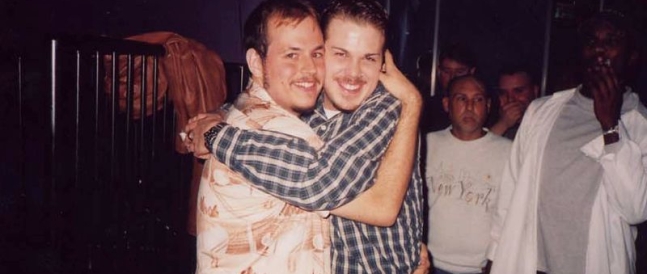Walks between Worlds
I have learned everything I know about Touch Practice by practicing, by holding men. Hundreds of men. Hundreds of different men. Very, very different men.
Some of the men I hold are conservative Republicans.
Some are liberal Democrats.
Some of the men I hold are happily and openly gay.
Some are straight and homophobic.
Some are gay and homophobic.
Some investigate Touch Practice secretly, fearfully, dreading that someone else might find out.
Some go home and tell all their friends about it. (Sometimes this includes wives. Sometimes it includes husbands.)
Some of the men I hold are religious people who cannot fathom “gay” as an integral part of God’s perfect creation.
Some are gay men who perceive “religious” people to be about as far away from God as one can get.
Each sees the other as without hope.
I hold all these men without becoming them and without becoming their opposite. I walk in the space in between.
 The practice is to hold the space between men and to meet them in the space. The space is always neutral. To hold the space, I can’t hold what the men in it are holding; I have to hold the space itself. To sit comfortably with any political point of view, any orientation, any spiritual practice, I have to hold something bigger than that point of view, orientation, or practice. I have to try to practice to hold everything. Everything that exists, everything that’s possible.
The practice is to hold the space between men and to meet them in the space. The space is always neutral. To hold the space, I can’t hold what the men in it are holding; I have to hold the space itself. To sit comfortably with any political point of view, any orientation, any spiritual practice, I have to hold something bigger than that point of view, orientation, or practice. I have to try to practice to hold everything. Everything that exists, everything that’s possible.
(“Good luck with that, Kevin. Hope it goes well for you, buddy.”)
Let me finish laughing for a moment, and then I’ll continue writing.
I’ve written a great deal here about projection and attribution, and the assumptions we make about each other. Unless someone actually knows me, personally, which is usually not the case, then the stranger I am holding tends to assume that I see the world the way they see the world, even though I’ve never, not even once, sat with someone who was exactly like me. There isn’t anyone exactly like me.
So, because of the way projection works, the conservative Republicans I hold tend to automatically assume that I, too, am a conservative Republican, and regularly send me anti-Obama emails. The liberal Democrats I hold assume that I am similarly with them on every cause and invite me to the appropriate facebook pages.
The straight-married-secretive men assume that I too am a straight married secretive man, while openly, comfortably gay men assume that I am one of them. People who are not getting enough sex assume that I too am a person who is not getting enough sex; people who have way more sex than they need or want and are desperately seeking alternatives assume that that’s the same thing that’s motivating me, too.
It is utterly fascinating to practice in this space. More fascinating than having all of these various things projected onto me, however, is noticing that they’re extremely polarized, binary, black and white opposites. (Most people aren’t purely conservative or liberal. Most people aren’t completely open about every aspect of their lives nor do they lie about everything. Most people are somewhere in between.)
 There is much to be learned by sitting in opposites, by having one foot in each world. There is interesting scenery. For example, staunchly religious, homophobic people and staunchly gay, anti-religious men each tend to see the “other” as being beyond their senses. Except for the labels, they perceive each other in exactly the same way: as having been “cast out” or having “fallen away” from Love (or intelligence, or common sense.)
There is much to be learned by sitting in opposites, by having one foot in each world. There is interesting scenery. For example, staunchly religious, homophobic people and staunchly gay, anti-religious men each tend to see the “other” as being beyond their senses. Except for the labels, they perceive each other in exactly the same way: as having been “cast out” or having “fallen away” from Love (or intelligence, or common sense.)
While these two types of men could not be more dissimilar in one sense, in one very important way they’re exactly alike: they both have a narrow, fearful conception of “who’s in.” Both groups are characterized by the same fear, contraction and suspicion, a sense of safety created by using exclusion rather than inclusion. This contracted, fearful posture is what these men have in common, so much so that I can feel it in their bodies when I hold them. They might have polar opposite world views and political affiliations, but the feeling in the body is exactly the same. They are carrying themselves through life waiting to collide with something “other” rather than understanding that “other” is already part of creation, already within us.
Whether I sit with a religious person who is afraid of gay people or a gay man afraid of religious people, I’m happy to sit in that space with them. That’s their space. The practice of walking between worlds means that I don’t try to reconcile or adjust one world to fit the other. Rather, the practice is to get comfortable as a visitor. I can sit with fear. I can sit with grief. The best way to sit with a man who arbitrarily excludes a part of creation is to try my best not to arbitrarily exclude any part of his.
Compassion isn’t cloning. To enter and sit with the heart of another person doesn’t mean we have to become exactly like them, nor does it mean we have to try to find a way to get them to become more like us. Compassion isn’t manipulative. It trusts that love, love itself, is enough. To hold the space in between and invite the “other” in, that’s enough.
Ironically, the world might be a better place if we could take a step towards each other and live a little less in polar opposites. Take, for example, Democrats and Republicans. As I mentioned, very few people in the country agree 100 percent with either party; most of us are some sort of mixture. Is it any coincidence that most of our recent elections have been split almost 50/50 in one way or another–whether the vote for the President himself, or whether we have a Dem in the white house and promptly elect a Republican congress, then switch four years later–if you watch our country, it’s obvious that somehow we’re trying to walk right down the middle or to combine elements of both.
It’s also (painfully) obvious that we’re not doing that very skillfully. Not yet.
I do have confidence that we’ll get there someday, however. It seems clear that we know where we’re trying to end up (in the middle, or encompassing all, rather than choosing between one or the other.) We just haven’t learned how to get there yet. Seems the case with many of the other polar opposites (gay or straight, godly or godless, liberal or conservative, etc.) in which we’ve entangled ourselves.
 The practice of sitting in the space, walking between worlds, sitting with things (and with men) that seem opposed and even irreconcilable has been one of the richest experiences of life for me, because in between those polar opposites is everything that has ever been created and all that exists. Touch Practice is a practice of making space for each other and sitting in the space together, and the only limit on how big that space can be is the limit of human imperfection. The space is, ultimately, big enough for each of us and for all of us.
The practice of sitting in the space, walking between worlds, sitting with things (and with men) that seem opposed and even irreconcilable has been one of the richest experiences of life for me, because in between those polar opposites is everything that has ever been created and all that exists. Touch Practice is a practice of making space for each other and sitting in the space together, and the only limit on how big that space can be is the limit of human imperfection. The space is, ultimately, big enough for each of us and for all of us.
Have thoughts you’d like to share?
Touch Practice is a sacred practice for me, and part of that is keeping confidences sacred. While a name and e-mail address are required to post a comment, feel free to use just your first name, or a pseudonym if you wish. Your e-mail address will never be seen by or shared with anyone. It is used to prevent spam and inappropriate comments from appearing in the blog. I’d really like to hear from you!













